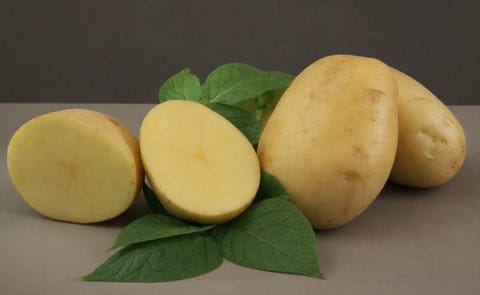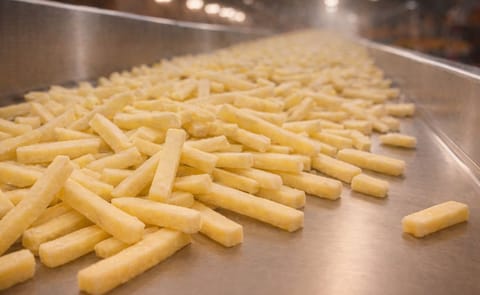A global development organisation has helped devise a method to increase the shelf life of the produce.
主标签
In Jharkhand, India a homegrown innovation is driving up potato farmers' incomes

A global development organisation has helped devise a method to increase the shelf life of the produce.
Anita Devi’s life was different even a year ago. A potato farmer from Jharkhand, her fortunes have taken a turn for the better. Earlier, a distressed farmer dealing with huge post-harvest losses, she has now turned into a confident woman, who can meet unforeseen financial exigencies.
A resident of Chanda village in Ichak block of Hazaribagh district, Jharkhand, Anita earns her livelihood by growing and selling potatoes. However, like most of her fellow farmers, Anita used to suffer heavy losses due to the practice of storing harvested potatoes underneath beds and cots in homes.
This not only caused wrinkling and shrivelling of her precious produce, but also resulted in blight disease that made them rot.
Most of these farmers lack proper storage space. As they are smallholders, their production volume is not that high for cold chains. Moreover, cold chains are expensive and, for many, going long distances to keep produce in cold chains is an issue. Things changed, however, over the last two years.
In 2017, global development organisation Digital Green, along with the Jharkhand State Livelihood Promotion Society, introduced a set of smart practices among Jharkhand’s smallholder farmers, who mainly grow potatoes for subsistence.
One of the innovative interventions introduced was the building of two-tier, three-foot by six-foot bamboo structures where harvested potatoes can be stored. These structures can be dismantled and customised as per needs.
Anita:
“Earlier, if I grew six quintals [600 kg] of potatoes, almost three quintals used to rot within three [to] four months. This structure keeps my potatoes fresh for almost six [to] seven months.”The stored potatoes also used to leave ugly marks on the floor, said Reena Devi, a farmer in Ichak’s Shailkala village, who also had a two-tier structure built in her house.
A big advantage of the new method is that cleaning of potatoes is not necessary on a regular basis when kept in the bamboo structure. The potatoes get enough light and fresh air and stay firm, she explained. Reena Devi just turns over her potatoes once in 15-20 days.
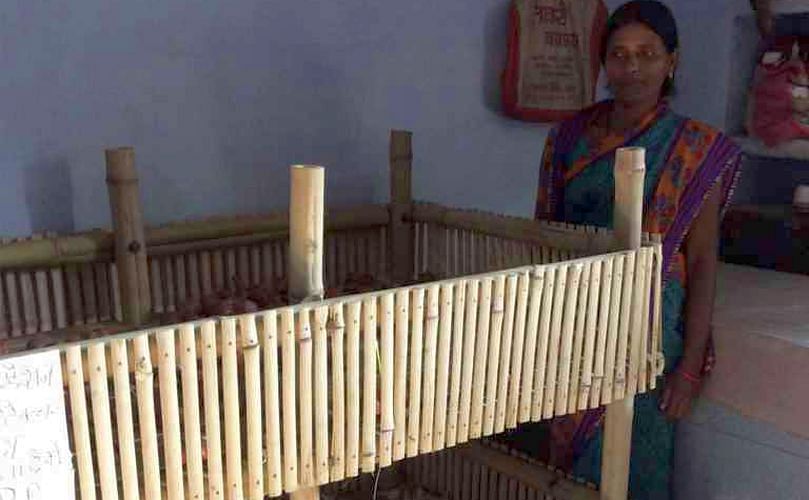
Bamboo structures used to store potatoes have increased their shelf life and reduced wastage. (Courtesy: Deepanwita Gita Niyogi)
Cultivators can store their produce for months without worrying. The two-tier structure holds six quintals of potatoes, with one stack holding three quintals at a time.
Tanuja:
“Apart from being able to store potatoes for our own consumption, we can now wait to sell them when rates are high. I also keep colocasia in my five-month-old bamboo structure after a thorough cleaning.”Her structure was built over three days by a local carpenter. Tanuja’s income, like most other farmers’, has increased since the bamboo structures came into use. Earlier, 50 kg of potato seeds used to yield 100 kg potatoes on a 2,169-sq-ft land. Now, 50 kg seeds give 150 kg to 200 kg of produce.
Anita has six quintals storage. In October 2019, the rate per kg was Rs 14, but she did not sell at that time. In November, she sold it at Rs 25 per kg. When rates are low, farmers don’t sell and keep in these structures.
Earlier, the potatoes used to rot a lot and used to become unfit for sale. With these structures, farmers said that the rate of rotting is low which ultimately means an increase in sales and more money for them.
Homegrown innovation
According to the United Nations’ Food and Agriculture Organization, a specialised agency that leads international efforts to defeat hunger, smallholders or family farmers are crucial to the eradication of rural poverty, hunger and malnutrition and in preserving natural resources and biodiversity.
About 80% of the world’s farmers are smallholders and supporting them is the need of the hour.
Ritesh Kumar, deputy programme manager at Digital Green, shares how the idea germinated. He said a discussion was held with 150 farmers of the Ichak village who all suffered due to the lack of proper storage facility and that is where this idea first took shape.
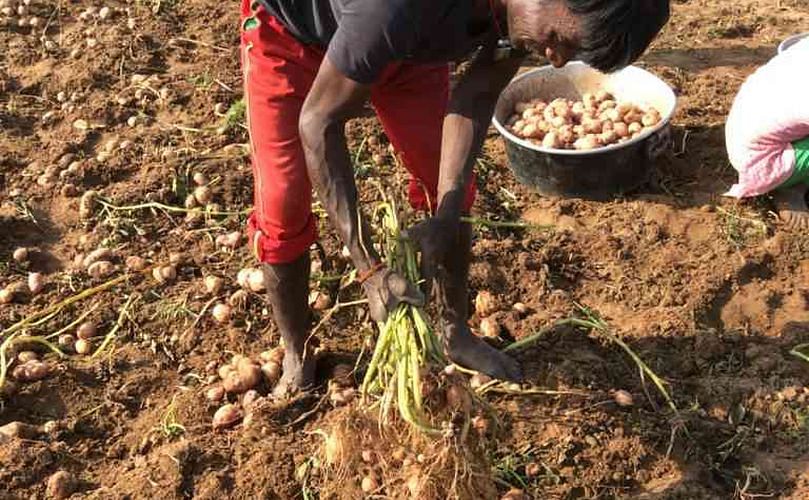
A farmer digs out potatoes in Ichak block. (Courtesy: Deepanwita Gita Niyogi.)
Kumar explained that the talks with farmers gave them an idea about cultivation practices and hurdles. 'We came to know that potato loss was high during storage,' he said.
According to Kumar, the bamboo structures, which promote the idea of household storage, have helped reduce rotting to a great extent. Earlier, if a farmer harvested a quintal of potatoes, 60 kg used to rot. But the bamboo storage facility has brought the loss down to 10 kg-20 kg – a big difference to the farmers.
The two-layered structures cost Rs 1,500 and can come down to around Rs 700 or 800 if the bamboo is provided by the farmers themselves. In Ichak, the cost of some of the structures was borne by the non-profit Srijan Foundation, which is helping Digital Green implement the programme.
Dayal Prasad, the block coordinator for Srijan, informed that the non-profit pays for nuts, bolts and carpenters’ fees while most farmers provide the bamboo. In Chanda village, 22 such structures have been built. One needs four to five bamboo logs for a two-tier structure.
Kumari Nikki, a community mobiliser for Srijan Foundation:
“The rates of bamboo vary according to quality. Bamboo has been chosen as it is lighter than wood and is not affected by pests.”As far as the benefits of using bamboo is concerned, it was pointed out that it is definitely cheaper than wood and lighter in weight too, but their cost varies according to availability, locality and quality.
Greater gains
The bamboo storage structure is part of the potato package of practices, which lays down certain guidelines for increased production. Selection and treatment of seeds is the most important factor according to the package.
These practices were launched to increase potato production in Jharkhand, which has always been low compared to Bihar, where a standard packet of seeds yields six packets of potatoes.
One packet holds about 50 kg of potatoes. In Jharkhand, the yield stood at three packets. But now, farmers are getting five packets after harvest, thereby increasing their income.
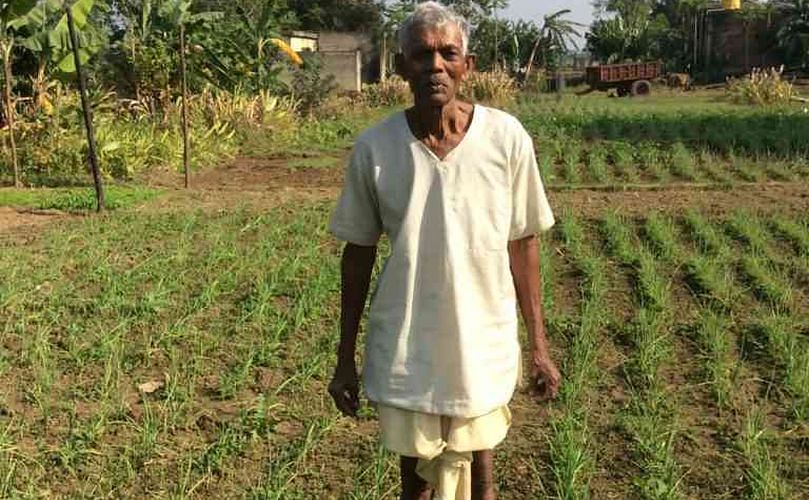
Gandori Mahato of Kaladwar village in Ichak block in his farm. (Courtesy: Deepanwita Gita Niyogi/Mongabay)
Potatoes weighing 30 gm-35 gm – they are used as seeds – are considered ideal for sowing, said Prasad. Farmers need to soak the seeds in M-45 solution, a fungicide, for 15 minutes to prevent wrinkling.
The sprinkling of trichoderma powder, which is used for plant diseases, is also important for disease control.
After that, the potatoes are grown on raised beds. Farmers are also advised to dig a set of irrigation furrows for optimum water supply. Mahato has been following these practices for the last two years on his 217-sq-ft plot. 'The distance between the two plants should be six inches. If planted closer, the production goes down,' he said.
Potato package of practices was launched in 2017 by Digital Green to increase potato production in Jharkhand, where its yield has been low compared to other states. Potato was chosen because it is a very basic crop and is cheaper than many other vegetables.
Kumar said that in the beginning, 9,000 farmers were targeted by Digital Green for the potato set of practices. Now, the scale has gone up to include 20,000 farmers across 12 districts in 24 blocks of Jharkhand.
Kumar:
“Most of these farmers now have more to offer to the markets as production has jumped and post-harvest losses have reduced.”Uttar Pradesh-based agriculture expert Ravi Bhushan Singh said that potatoes are a perishable item. The harvest period window is usually low – 15 to 20 days – unlike other crops. This results in a glut and the prices come down. He said storing the harvest for a longer time, therefore, becomes necessary.
Ravi Bhushan Singh, Uttar Pradesh-based agriculture expert:
“This is where the multi-layered portable structures made of locally available materials was the ideal solution to the problem.”

